Sustainable and Responsible Tourism Management Practices in Paris
VerifiedAdded on 2023/06/18
|16
|5187
|488
Report
AI Summary
This report provides a detailed analysis of sustainable and responsible tourism management, focusing on Paris, France, as a case study. It explores the evolution of sustainable tourism concepts, the roles of global organizations like the UNWTO, and the principles and processes of tourism development aimed at minimizing adverse effects. The report examines the economic, social, cultural, and environmental impacts of tourism activities, emphasizing stakeholder engagement and partnerships. It also assesses the success and failures of sustainable management practices in Paris, offering solutions and recommendations for future improvements in the tourism sector. Desklib provides access to this and other solved assignments for students.
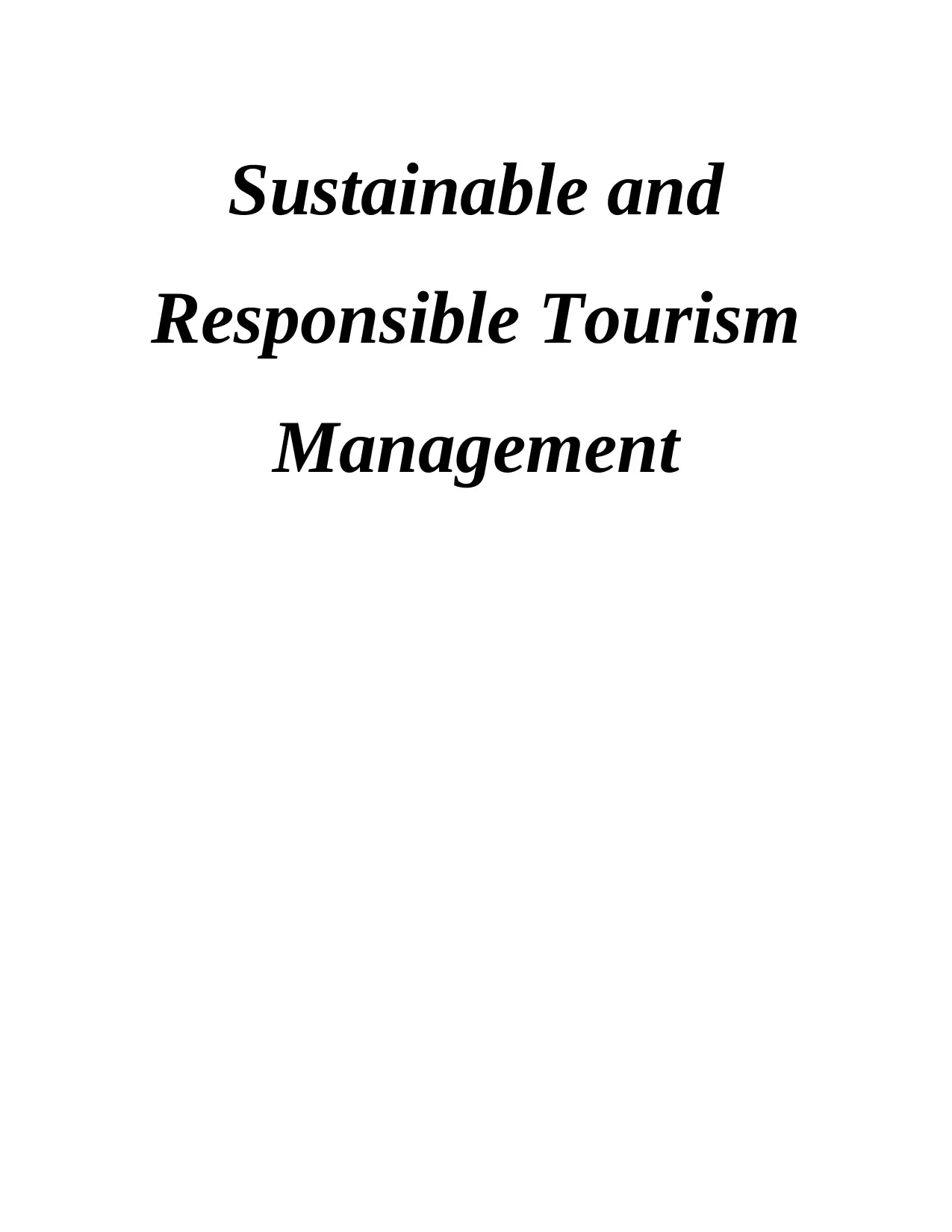
Sustainable and
Responsible Tourism
Management
Responsible Tourism
Management
Paraphrase This Document
Need a fresh take? Get an instant paraphrase of this document with our AI Paraphraser

Table of Contents
INTRODUCTION...........................................................................................................................1
Task 1...............................................................................................................................................1
P1, D1: Evolution of the concept of sustainable and responsible tourism with relevance and
application..............................................................................................................................1
P2, M1: Role, function and mission of leading global organisations involved in the promotion
of sustainable and responsible tourism...................................................................................2
Task 2...............................................................................................................................................3
P3: Purpose, principles and approaches of tourism development and planning to minimise the
adverse effects........................................................................................................................3
P4: Process of tourism development and planning.................................................................4
M2: Associated challenges and problems, providing specific tourism examples..................5
D2: Justify the rationale for measuring and monitoring sustainable performance.................6
Task 3...............................................................................................................................................7
P5: Impacts of tourism activity generated by a specific tourism attraction from an economic,
social, cultural and environmental perspective......................................................................7
P6: How principles of sustainability meets stakeholder requirements and expectations.......8
M3: Contribution made by various stakeholders in developing sustainable tourism practices. .8
D3: Value and importance of stakeholder engagement and partnerships in minimising adverse
impacts to meet overall sustainable objectives.......................................................................9
Task 4...............................................................................................................................................9
P7: How sustainability is being developed and managed in a range of tourist destinations
worldwide...............................................................................................................................9
M4, D4: Success or failure of sustainable management applied in a range of tourist
destinations worldwide.........................................................................................................10
Solutions and Recommendations...................................................................................................11
CONCLUSION..............................................................................................................................11
INTRODUCTION...........................................................................................................................1
Task 1...............................................................................................................................................1
P1, D1: Evolution of the concept of sustainable and responsible tourism with relevance and
application..............................................................................................................................1
P2, M1: Role, function and mission of leading global organisations involved in the promotion
of sustainable and responsible tourism...................................................................................2
Task 2...............................................................................................................................................3
P3: Purpose, principles and approaches of tourism development and planning to minimise the
adverse effects........................................................................................................................3
P4: Process of tourism development and planning.................................................................4
M2: Associated challenges and problems, providing specific tourism examples..................5
D2: Justify the rationale for measuring and monitoring sustainable performance.................6
Task 3...............................................................................................................................................7
P5: Impacts of tourism activity generated by a specific tourism attraction from an economic,
social, cultural and environmental perspective......................................................................7
P6: How principles of sustainability meets stakeholder requirements and expectations.......8
M3: Contribution made by various stakeholders in developing sustainable tourism practices. .8
D3: Value and importance of stakeholder engagement and partnerships in minimising adverse
impacts to meet overall sustainable objectives.......................................................................9
Task 4...............................................................................................................................................9
P7: How sustainability is being developed and managed in a range of tourist destinations
worldwide...............................................................................................................................9
M4, D4: Success or failure of sustainable management applied in a range of tourist
destinations worldwide.........................................................................................................10
Solutions and Recommendations...................................................................................................11
CONCLUSION..............................................................................................................................11

References:.....................................................................................................................................12
⊘ This is a preview!⊘
Do you want full access?
Subscribe today to unlock all pages.

Trusted by 1+ million students worldwide
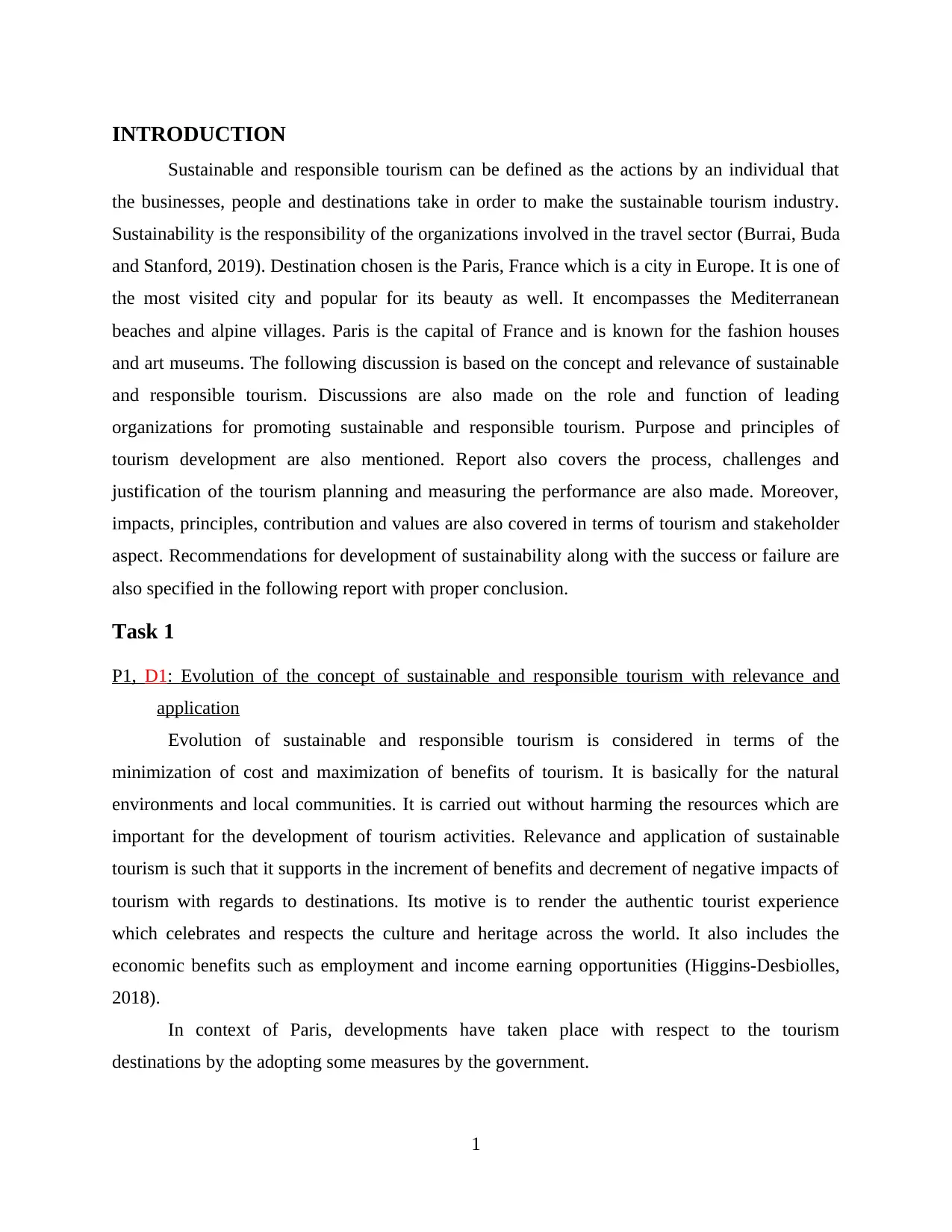
INTRODUCTION
Sustainable and responsible tourism can be defined as the actions by an individual that
the businesses, people and destinations take in order to make the sustainable tourism industry.
Sustainability is the responsibility of the organizations involved in the travel sector (Burrai, Buda
and Stanford, 2019). Destination chosen is the Paris, France which is a city in Europe. It is one of
the most visited city and popular for its beauty as well. It encompasses the Mediterranean
beaches and alpine villages. Paris is the capital of France and is known for the fashion houses
and art museums. The following discussion is based on the concept and relevance of sustainable
and responsible tourism. Discussions are also made on the role and function of leading
organizations for promoting sustainable and responsible tourism. Purpose and principles of
tourism development are also mentioned. Report also covers the process, challenges and
justification of the tourism planning and measuring the performance are also made. Moreover,
impacts, principles, contribution and values are also covered in terms of tourism and stakeholder
aspect. Recommendations for development of sustainability along with the success or failure are
also specified in the following report with proper conclusion.
Task 1
P1, D1: Evolution of the concept of sustainable and responsible tourism with relevance and
application
Evolution of sustainable and responsible tourism is considered in terms of the
minimization of cost and maximization of benefits of tourism. It is basically for the natural
environments and local communities. It is carried out without harming the resources which are
important for the development of tourism activities. Relevance and application of sustainable
tourism is such that it supports in the increment of benefits and decrement of negative impacts of
tourism with regards to destinations. Its motive is to render the authentic tourist experience
which celebrates and respects the culture and heritage across the world. It also includes the
economic benefits such as employment and income earning opportunities (Higgins-Desbiolles,
2018).
In context of Paris, developments have taken place with respect to the tourism
destinations by the adopting some measures by the government.
1
Sustainable and responsible tourism can be defined as the actions by an individual that
the businesses, people and destinations take in order to make the sustainable tourism industry.
Sustainability is the responsibility of the organizations involved in the travel sector (Burrai, Buda
and Stanford, 2019). Destination chosen is the Paris, France which is a city in Europe. It is one of
the most visited city and popular for its beauty as well. It encompasses the Mediterranean
beaches and alpine villages. Paris is the capital of France and is known for the fashion houses
and art museums. The following discussion is based on the concept and relevance of sustainable
and responsible tourism. Discussions are also made on the role and function of leading
organizations for promoting sustainable and responsible tourism. Purpose and principles of
tourism development are also mentioned. Report also covers the process, challenges and
justification of the tourism planning and measuring the performance are also made. Moreover,
impacts, principles, contribution and values are also covered in terms of tourism and stakeholder
aspect. Recommendations for development of sustainability along with the success or failure are
also specified in the following report with proper conclusion.
Task 1
P1, D1: Evolution of the concept of sustainable and responsible tourism with relevance and
application
Evolution of sustainable and responsible tourism is considered in terms of the
minimization of cost and maximization of benefits of tourism. It is basically for the natural
environments and local communities. It is carried out without harming the resources which are
important for the development of tourism activities. Relevance and application of sustainable
tourism is such that it supports in the increment of benefits and decrement of negative impacts of
tourism with regards to destinations. Its motive is to render the authentic tourist experience
which celebrates and respects the culture and heritage across the world. It also includes the
economic benefits such as employment and income earning opportunities (Higgins-Desbiolles,
2018).
In context of Paris, developments have taken place with respect to the tourism
destinations by the adopting some measures by the government.
1
Paraphrase This Document
Need a fresh take? Get an instant paraphrase of this document with our AI Paraphraser
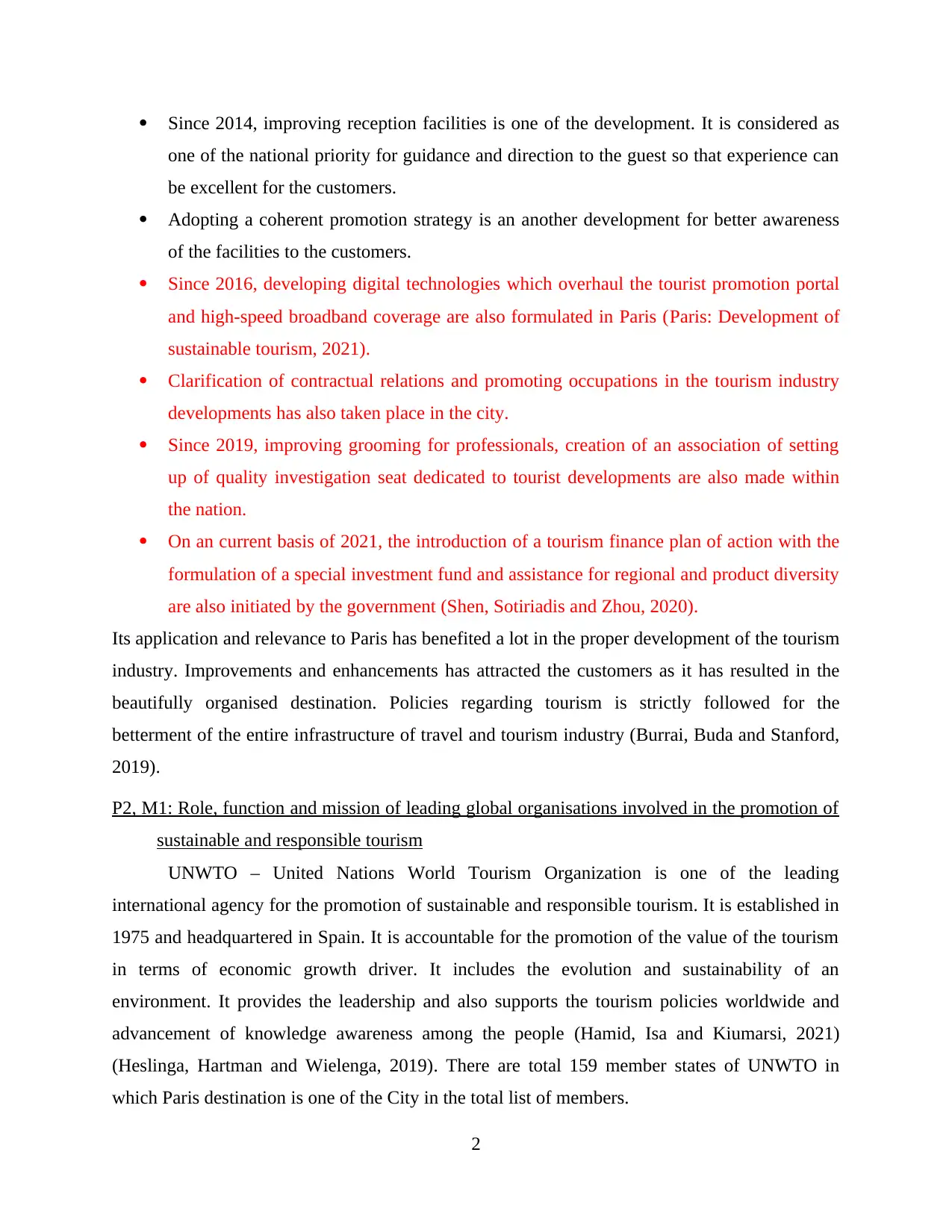
Since 2014, improving reception facilities is one of the development. It is considered as
one of the national priority for guidance and direction to the guest so that experience can
be excellent for the customers.
Adopting a coherent promotion strategy is an another development for better awareness
of the facilities to the customers.
Since 2016, developing digital technologies which overhaul the tourist promotion portal
and high-speed broadband coverage are also formulated in Paris (Paris: Development of
sustainable tourism, 2021).
Clarification of contractual relations and promoting occupations in the tourism industry
developments has also taken place in the city.
Since 2019, improving grooming for professionals, creation of an association of setting
up of quality investigation seat dedicated to tourist developments are also made within
the nation.
On an current basis of 2021, the introduction of a tourism finance plan of action with the
formulation of a special investment fund and assistance for regional and product diversity
are also initiated by the government (Shen, Sotiriadis and Zhou, 2020).
Its application and relevance to Paris has benefited a lot in the proper development of the tourism
industry. Improvements and enhancements has attracted the customers as it has resulted in the
beautifully organised destination. Policies regarding tourism is strictly followed for the
betterment of the entire infrastructure of travel and tourism industry (Burrai, Buda and Stanford,
2019).
P2, M1: Role, function and mission of leading global organisations involved in the promotion of
sustainable and responsible tourism
UNWTO – United Nations World Tourism Organization is one of the leading
international agency for the promotion of sustainable and responsible tourism. It is established in
1975 and headquartered in Spain. It is accountable for the promotion of the value of the tourism
in terms of economic growth driver. It includes the evolution and sustainability of an
environment. It provides the leadership and also supports the tourism policies worldwide and
advancement of knowledge awareness among the people (Hamid, Isa and Kiumarsi, 2021)
(Heslinga, Hartman and Wielenga, 2019). There are total 159 member states of UNWTO in
which Paris destination is one of the City in the total list of members.
2
one of the national priority for guidance and direction to the guest so that experience can
be excellent for the customers.
Adopting a coherent promotion strategy is an another development for better awareness
of the facilities to the customers.
Since 2016, developing digital technologies which overhaul the tourist promotion portal
and high-speed broadband coverage are also formulated in Paris (Paris: Development of
sustainable tourism, 2021).
Clarification of contractual relations and promoting occupations in the tourism industry
developments has also taken place in the city.
Since 2019, improving grooming for professionals, creation of an association of setting
up of quality investigation seat dedicated to tourist developments are also made within
the nation.
On an current basis of 2021, the introduction of a tourism finance plan of action with the
formulation of a special investment fund and assistance for regional and product diversity
are also initiated by the government (Shen, Sotiriadis and Zhou, 2020).
Its application and relevance to Paris has benefited a lot in the proper development of the tourism
industry. Improvements and enhancements has attracted the customers as it has resulted in the
beautifully organised destination. Policies regarding tourism is strictly followed for the
betterment of the entire infrastructure of travel and tourism industry (Burrai, Buda and Stanford,
2019).
P2, M1: Role, function and mission of leading global organisations involved in the promotion of
sustainable and responsible tourism
UNWTO – United Nations World Tourism Organization is one of the leading
international agency for the promotion of sustainable and responsible tourism. It is established in
1975 and headquartered in Spain. It is accountable for the promotion of the value of the tourism
in terms of economic growth driver. It includes the evolution and sustainability of an
environment. It provides the leadership and also supports the tourism policies worldwide and
advancement of knowledge awareness among the people (Hamid, Isa and Kiumarsi, 2021)
(Heslinga, Hartman and Wielenga, 2019). There are total 159 member states of UNWTO in
which Paris destination is one of the City in the total list of members.
2
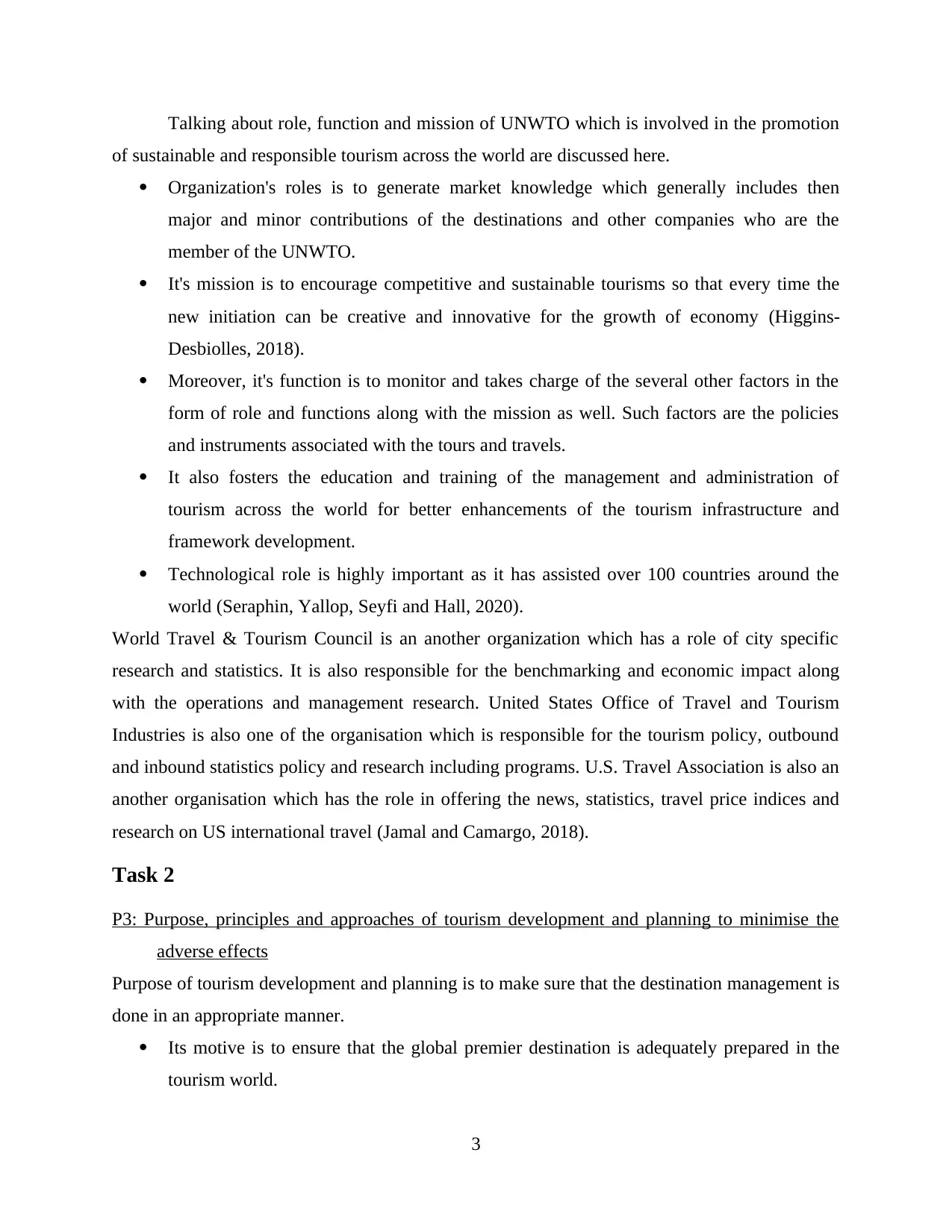
Talking about role, function and mission of UNWTO which is involved in the promotion
of sustainable and responsible tourism across the world are discussed here.
Organization's roles is to generate market knowledge which generally includes then
major and minor contributions of the destinations and other companies who are the
member of the UNWTO.
It's mission is to encourage competitive and sustainable tourisms so that every time the
new initiation can be creative and innovative for the growth of economy (Higgins-
Desbiolles, 2018).
Moreover, it's function is to monitor and takes charge of the several other factors in the
form of role and functions along with the mission as well. Such factors are the policies
and instruments associated with the tours and travels.
It also fosters the education and training of the management and administration of
tourism across the world for better enhancements of the tourism infrastructure and
framework development.
Technological role is highly important as it has assisted over 100 countries around the
world (Seraphin, Yallop, Seyfi and Hall, 2020).
World Travel & Tourism Council is an another organization which has a role of city specific
research and statistics. It is also responsible for the benchmarking and economic impact along
with the operations and management research. United States Office of Travel and Tourism
Industries is also one of the organisation which is responsible for the tourism policy, outbound
and inbound statistics policy and research including programs. U.S. Travel Association is also an
another organisation which has the role in offering the news, statistics, travel price indices and
research on US international travel (Jamal and Camargo, 2018).
Task 2
P3: Purpose, principles and approaches of tourism development and planning to minimise the
adverse effects
Purpose of tourism development and planning is to make sure that the destination management is
done in an appropriate manner.
Its motive is to ensure that the global premier destination is adequately prepared in the
tourism world.
3
of sustainable and responsible tourism across the world are discussed here.
Organization's roles is to generate market knowledge which generally includes then
major and minor contributions of the destinations and other companies who are the
member of the UNWTO.
It's mission is to encourage competitive and sustainable tourisms so that every time the
new initiation can be creative and innovative for the growth of economy (Higgins-
Desbiolles, 2018).
Moreover, it's function is to monitor and takes charge of the several other factors in the
form of role and functions along with the mission as well. Such factors are the policies
and instruments associated with the tours and travels.
It also fosters the education and training of the management and administration of
tourism across the world for better enhancements of the tourism infrastructure and
framework development.
Technological role is highly important as it has assisted over 100 countries around the
world (Seraphin, Yallop, Seyfi and Hall, 2020).
World Travel & Tourism Council is an another organization which has a role of city specific
research and statistics. It is also responsible for the benchmarking and economic impact along
with the operations and management research. United States Office of Travel and Tourism
Industries is also one of the organisation which is responsible for the tourism policy, outbound
and inbound statistics policy and research including programs. U.S. Travel Association is also an
another organisation which has the role in offering the news, statistics, travel price indices and
research on US international travel (Jamal and Camargo, 2018).
Task 2
P3: Purpose, principles and approaches of tourism development and planning to minimise the
adverse effects
Purpose of tourism development and planning is to make sure that the destination management is
done in an appropriate manner.
Its motive is to ensure that the global premier destination is adequately prepared in the
tourism world.
3
⊘ This is a preview!⊘
Do you want full access?
Subscribe today to unlock all pages.

Trusted by 1+ million students worldwide
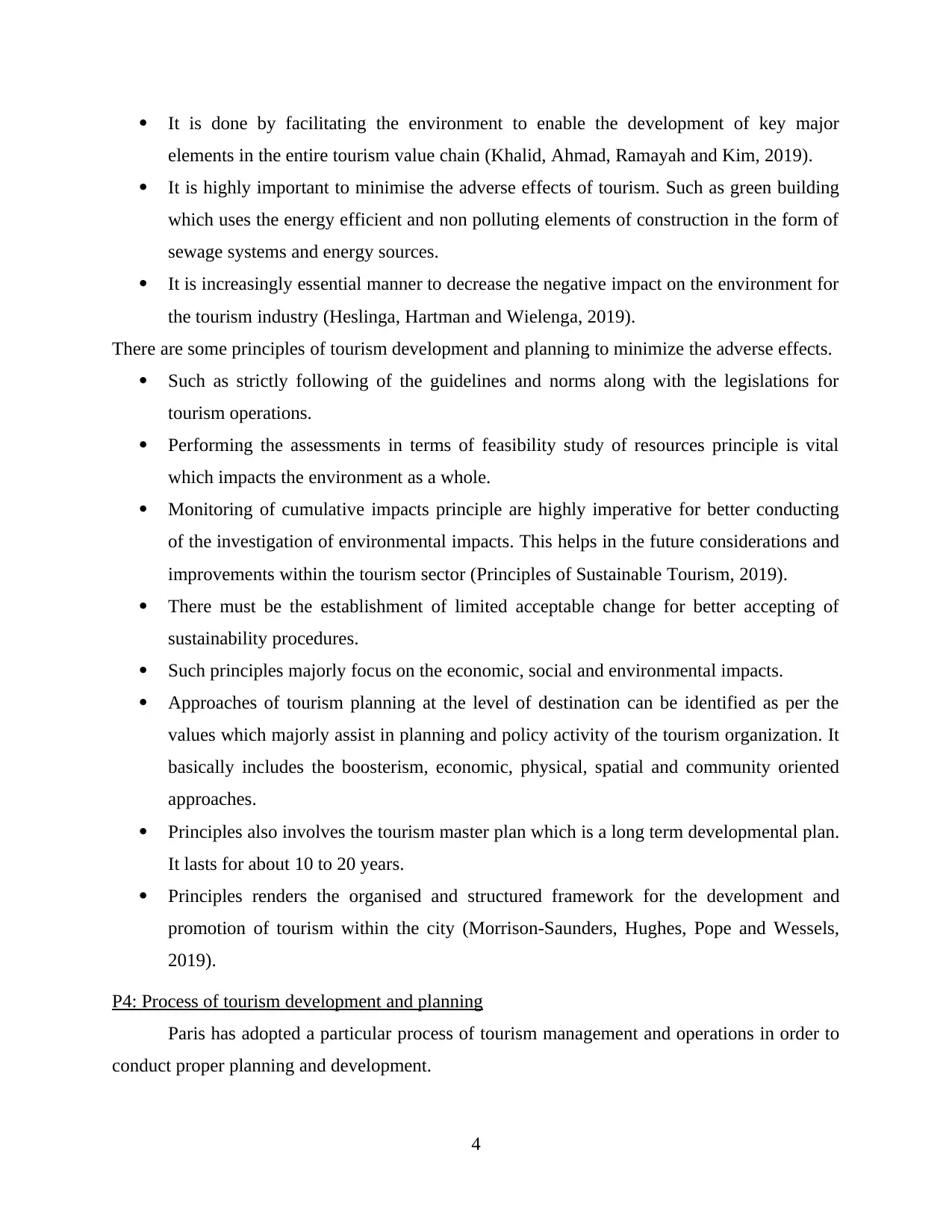
It is done by facilitating the environment to enable the development of key major
elements in the entire tourism value chain (Khalid, Ahmad, Ramayah and Kim, 2019).
It is highly important to minimise the adverse effects of tourism. Such as green building
which uses the energy efficient and non polluting elements of construction in the form of
sewage systems and energy sources.
It is increasingly essential manner to decrease the negative impact on the environment for
the tourism industry (Heslinga, Hartman and Wielenga, 2019).
There are some principles of tourism development and planning to minimize the adverse effects.
Such as strictly following of the guidelines and norms along with the legislations for
tourism operations.
Performing the assessments in terms of feasibility study of resources principle is vital
which impacts the environment as a whole.
Monitoring of cumulative impacts principle are highly imperative for better conducting
of the investigation of environmental impacts. This helps in the future considerations and
improvements within the tourism sector (Principles of Sustainable Tourism, 2019).
There must be the establishment of limited acceptable change for better accepting of
sustainability procedures.
Such principles majorly focus on the economic, social and environmental impacts.
Approaches of tourism planning at the level of destination can be identified as per the
values which majorly assist in planning and policy activity of the tourism organization. It
basically includes the boosterism, economic, physical, spatial and community oriented
approaches.
Principles also involves the tourism master plan which is a long term developmental plan.
It lasts for about 10 to 20 years.
Principles renders the organised and structured framework for the development and
promotion of tourism within the city (Morrison-Saunders, Hughes, Pope and Wessels,
2019).
P4: Process of tourism development and planning
Paris has adopted a particular process of tourism management and operations in order to
conduct proper planning and development.
4
elements in the entire tourism value chain (Khalid, Ahmad, Ramayah and Kim, 2019).
It is highly important to minimise the adverse effects of tourism. Such as green building
which uses the energy efficient and non polluting elements of construction in the form of
sewage systems and energy sources.
It is increasingly essential manner to decrease the negative impact on the environment for
the tourism industry (Heslinga, Hartman and Wielenga, 2019).
There are some principles of tourism development and planning to minimize the adverse effects.
Such as strictly following of the guidelines and norms along with the legislations for
tourism operations.
Performing the assessments in terms of feasibility study of resources principle is vital
which impacts the environment as a whole.
Monitoring of cumulative impacts principle are highly imperative for better conducting
of the investigation of environmental impacts. This helps in the future considerations and
improvements within the tourism sector (Principles of Sustainable Tourism, 2019).
There must be the establishment of limited acceptable change for better accepting of
sustainability procedures.
Such principles majorly focus on the economic, social and environmental impacts.
Approaches of tourism planning at the level of destination can be identified as per the
values which majorly assist in planning and policy activity of the tourism organization. It
basically includes the boosterism, economic, physical, spatial and community oriented
approaches.
Principles also involves the tourism master plan which is a long term developmental plan.
It lasts for about 10 to 20 years.
Principles renders the organised and structured framework for the development and
promotion of tourism within the city (Morrison-Saunders, Hughes, Pope and Wessels,
2019).
P4: Process of tourism development and planning
Paris has adopted a particular process of tourism management and operations in order to
conduct proper planning and development.
4
Paraphrase This Document
Need a fresh take? Get an instant paraphrase of this document with our AI Paraphraser
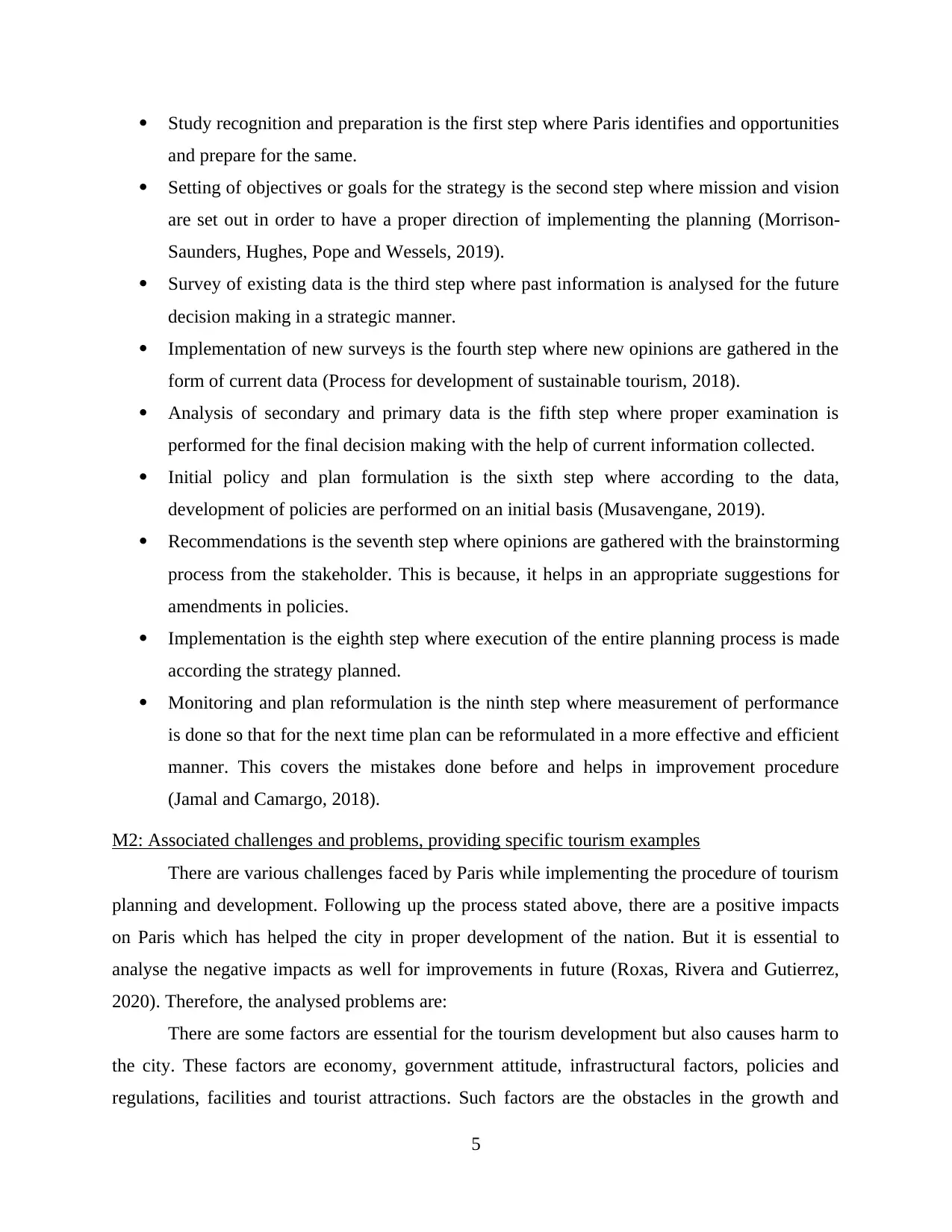
Study recognition and preparation is the first step where Paris identifies and opportunities
and prepare for the same.
Setting of objectives or goals for the strategy is the second step where mission and vision
are set out in order to have a proper direction of implementing the planning (Morrison-
Saunders, Hughes, Pope and Wessels, 2019).
Survey of existing data is the third step where past information is analysed for the future
decision making in a strategic manner.
Implementation of new surveys is the fourth step where new opinions are gathered in the
form of current data (Process for development of sustainable tourism, 2018).
Analysis of secondary and primary data is the fifth step where proper examination is
performed for the final decision making with the help of current information collected.
Initial policy and plan formulation is the sixth step where according to the data,
development of policies are performed on an initial basis (Musavengane, 2019).
Recommendations is the seventh step where opinions are gathered with the brainstorming
process from the stakeholder. This is because, it helps in an appropriate suggestions for
amendments in policies.
Implementation is the eighth step where execution of the entire planning process is made
according the strategy planned.
Monitoring and plan reformulation is the ninth step where measurement of performance
is done so that for the next time plan can be reformulated in a more effective and efficient
manner. This covers the mistakes done before and helps in improvement procedure
(Jamal and Camargo, 2018).
M2: Associated challenges and problems, providing specific tourism examples
There are various challenges faced by Paris while implementing the procedure of tourism
planning and development. Following up the process stated above, there are a positive impacts
on Paris which has helped the city in proper development of the nation. But it is essential to
analyse the negative impacts as well for improvements in future (Roxas, Rivera and Gutierrez,
2020). Therefore, the analysed problems are:
There are some factors are essential for the tourism development but also causes harm to
the city. These factors are economy, government attitude, infrastructural factors, policies and
regulations, facilities and tourist attractions. Such factors are the obstacles in the growth and
5
and prepare for the same.
Setting of objectives or goals for the strategy is the second step where mission and vision
are set out in order to have a proper direction of implementing the planning (Morrison-
Saunders, Hughes, Pope and Wessels, 2019).
Survey of existing data is the third step where past information is analysed for the future
decision making in a strategic manner.
Implementation of new surveys is the fourth step where new opinions are gathered in the
form of current data (Process for development of sustainable tourism, 2018).
Analysis of secondary and primary data is the fifth step where proper examination is
performed for the final decision making with the help of current information collected.
Initial policy and plan formulation is the sixth step where according to the data,
development of policies are performed on an initial basis (Musavengane, 2019).
Recommendations is the seventh step where opinions are gathered with the brainstorming
process from the stakeholder. This is because, it helps in an appropriate suggestions for
amendments in policies.
Implementation is the eighth step where execution of the entire planning process is made
according the strategy planned.
Monitoring and plan reformulation is the ninth step where measurement of performance
is done so that for the next time plan can be reformulated in a more effective and efficient
manner. This covers the mistakes done before and helps in improvement procedure
(Jamal and Camargo, 2018).
M2: Associated challenges and problems, providing specific tourism examples
There are various challenges faced by Paris while implementing the procedure of tourism
planning and development. Following up the process stated above, there are a positive impacts
on Paris which has helped the city in proper development of the nation. But it is essential to
analyse the negative impacts as well for improvements in future (Roxas, Rivera and Gutierrez,
2020). Therefore, the analysed problems are:
There are some factors are essential for the tourism development but also causes harm to
the city. These factors are economy, government attitude, infrastructural factors, policies and
regulations, facilities and tourist attractions. Such factors are the obstacles in the growth and
5
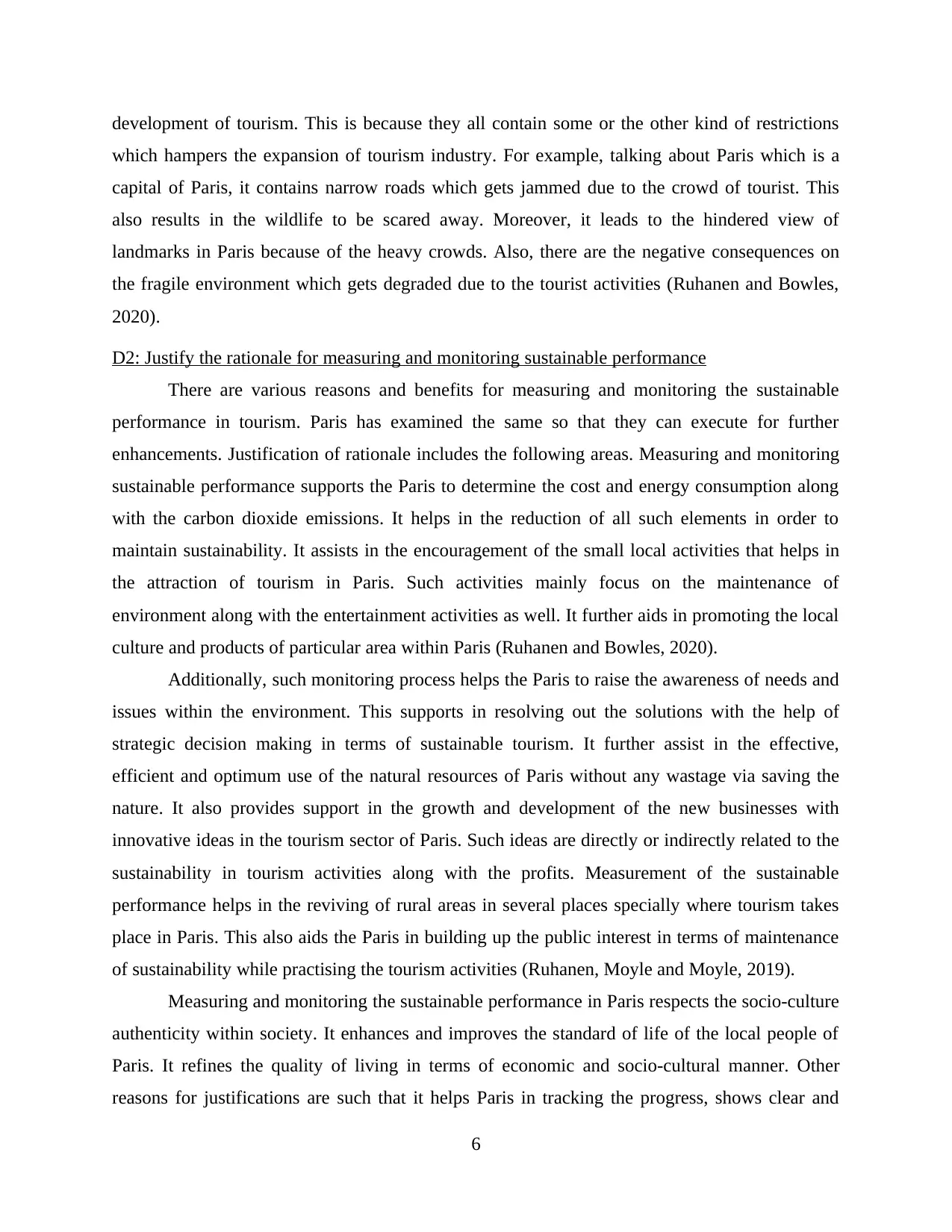
development of tourism. This is because they all contain some or the other kind of restrictions
which hampers the expansion of tourism industry. For example, talking about Paris which is a
capital of Paris, it contains narrow roads which gets jammed due to the crowd of tourist. This
also results in the wildlife to be scared away. Moreover, it leads to the hindered view of
landmarks in Paris because of the heavy crowds. Also, there are the negative consequences on
the fragile environment which gets degraded due to the tourist activities (Ruhanen and Bowles,
2020).
D2: Justify the rationale for measuring and monitoring sustainable performance
There are various reasons and benefits for measuring and monitoring the sustainable
performance in tourism. Paris has examined the same so that they can execute for further
enhancements. Justification of rationale includes the following areas. Measuring and monitoring
sustainable performance supports the Paris to determine the cost and energy consumption along
with the carbon dioxide emissions. It helps in the reduction of all such elements in order to
maintain sustainability. It assists in the encouragement of the small local activities that helps in
the attraction of tourism in Paris. Such activities mainly focus on the maintenance of
environment along with the entertainment activities as well. It further aids in promoting the local
culture and products of particular area within Paris (Ruhanen and Bowles, 2020).
Additionally, such monitoring process helps the Paris to raise the awareness of needs and
issues within the environment. This supports in resolving out the solutions with the help of
strategic decision making in terms of sustainable tourism. It further assist in the effective,
efficient and optimum use of the natural resources of Paris without any wastage via saving the
nature. It also provides support in the growth and development of the new businesses with
innovative ideas in the tourism sector of Paris. Such ideas are directly or indirectly related to the
sustainability in tourism activities along with the profits. Measurement of the sustainable
performance helps in the reviving of rural areas in several places specially where tourism takes
place in Paris. This also aids the Paris in building up the public interest in terms of maintenance
of sustainability while practising the tourism activities (Ruhanen, Moyle and Moyle, 2019).
Measuring and monitoring the sustainable performance in Paris respects the socio-culture
authenticity within society. It enhances and improves the standard of life of the local people of
Paris. It refines the quality of living in terms of economic and socio-cultural manner. Other
reasons for justifications are such that it helps Paris in tracking the progress, shows clear and
6
which hampers the expansion of tourism industry. For example, talking about Paris which is a
capital of Paris, it contains narrow roads which gets jammed due to the crowd of tourist. This
also results in the wildlife to be scared away. Moreover, it leads to the hindered view of
landmarks in Paris because of the heavy crowds. Also, there are the negative consequences on
the fragile environment which gets degraded due to the tourist activities (Ruhanen and Bowles,
2020).
D2: Justify the rationale for measuring and monitoring sustainable performance
There are various reasons and benefits for measuring and monitoring the sustainable
performance in tourism. Paris has examined the same so that they can execute for further
enhancements. Justification of rationale includes the following areas. Measuring and monitoring
sustainable performance supports the Paris to determine the cost and energy consumption along
with the carbon dioxide emissions. It helps in the reduction of all such elements in order to
maintain sustainability. It assists in the encouragement of the small local activities that helps in
the attraction of tourism in Paris. Such activities mainly focus on the maintenance of
environment along with the entertainment activities as well. It further aids in promoting the local
culture and products of particular area within Paris (Ruhanen and Bowles, 2020).
Additionally, such monitoring process helps the Paris to raise the awareness of needs and
issues within the environment. This supports in resolving out the solutions with the help of
strategic decision making in terms of sustainable tourism. It further assist in the effective,
efficient and optimum use of the natural resources of Paris without any wastage via saving the
nature. It also provides support in the growth and development of the new businesses with
innovative ideas in the tourism sector of Paris. Such ideas are directly or indirectly related to the
sustainability in tourism activities along with the profits. Measurement of the sustainable
performance helps in the reviving of rural areas in several places specially where tourism takes
place in Paris. This also aids the Paris in building up the public interest in terms of maintenance
of sustainability while practising the tourism activities (Ruhanen, Moyle and Moyle, 2019).
Measuring and monitoring the sustainable performance in Paris respects the socio-culture
authenticity within society. It enhances and improves the standard of life of the local people of
Paris. It refines the quality of living in terms of economic and socio-cultural manner. Other
reasons for justifications are such that it helps Paris in tracking the progress, shows clear and
6
⊘ This is a preview!⊘
Do you want full access?
Subscribe today to unlock all pages.

Trusted by 1+ million students worldwide
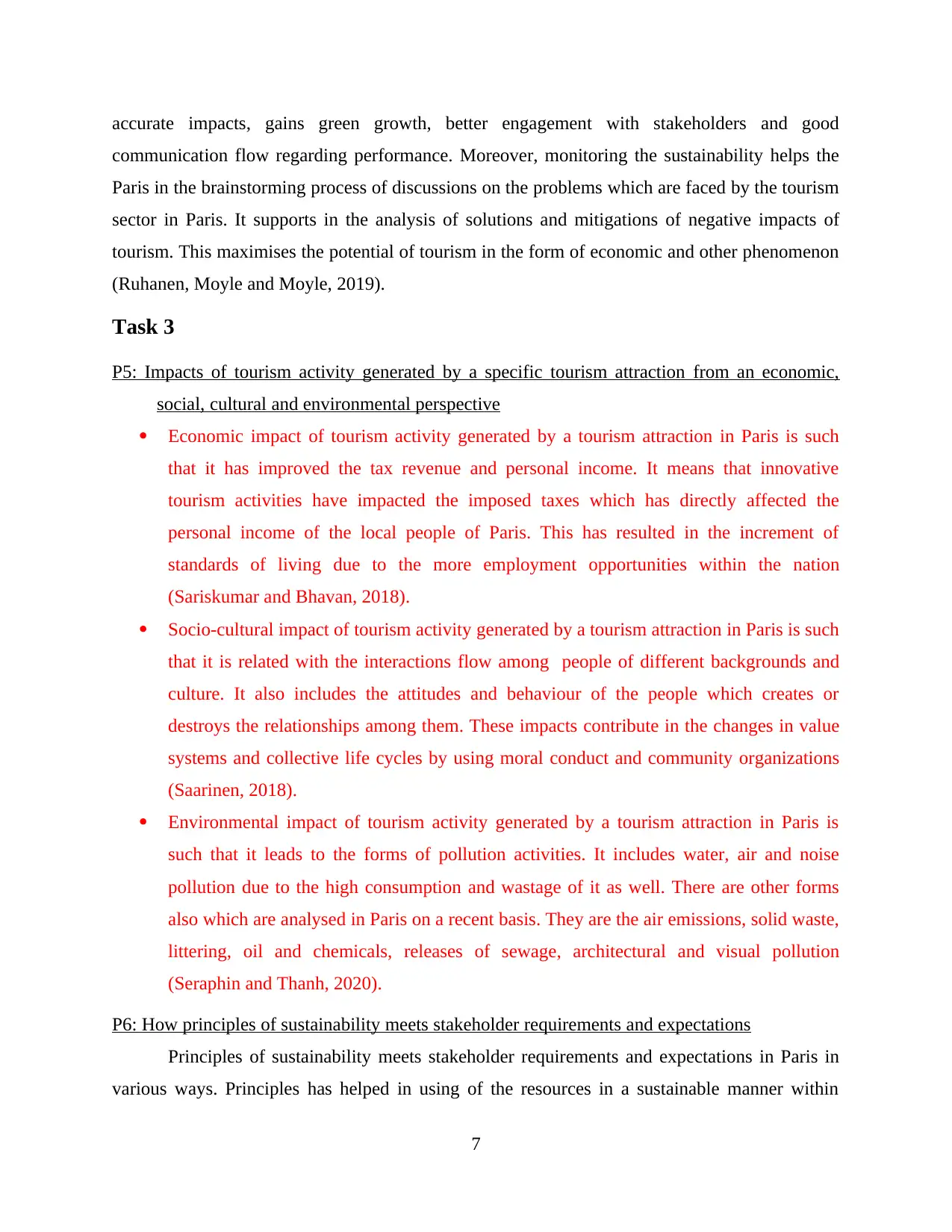
accurate impacts, gains green growth, better engagement with stakeholders and good
communication flow regarding performance. Moreover, monitoring the sustainability helps the
Paris in the brainstorming process of discussions on the problems which are faced by the tourism
sector in Paris. It supports in the analysis of solutions and mitigations of negative impacts of
tourism. This maximises the potential of tourism in the form of economic and other phenomenon
(Ruhanen, Moyle and Moyle, 2019).
Task 3
P5: Impacts of tourism activity generated by a specific tourism attraction from an economic,
social, cultural and environmental perspective
Economic impact of tourism activity generated by a tourism attraction in Paris is such
that it has improved the tax revenue and personal income. It means that innovative
tourism activities have impacted the imposed taxes which has directly affected the
personal income of the local people of Paris. This has resulted in the increment of
standards of living due to the more employment opportunities within the nation
(Sariskumar and Bhavan, 2018).
Socio-cultural impact of tourism activity generated by a tourism attraction in Paris is such
that it is related with the interactions flow among people of different backgrounds and
culture. It also includes the attitudes and behaviour of the people which creates or
destroys the relationships among them. These impacts contribute in the changes in value
systems and collective life cycles by using moral conduct and community organizations
(Saarinen, 2018).
Environmental impact of tourism activity generated by a tourism attraction in Paris is
such that it leads to the forms of pollution activities. It includes water, air and noise
pollution due to the high consumption and wastage of it as well. There are other forms
also which are analysed in Paris on a recent basis. They are the air emissions, solid waste,
littering, oil and chemicals, releases of sewage, architectural and visual pollution
(Seraphin and Thanh, 2020).
P6: How principles of sustainability meets stakeholder requirements and expectations
Principles of sustainability meets stakeholder requirements and expectations in Paris in
various ways. Principles has helped in using of the resources in a sustainable manner within
7
communication flow regarding performance. Moreover, monitoring the sustainability helps the
Paris in the brainstorming process of discussions on the problems which are faced by the tourism
sector in Paris. It supports in the analysis of solutions and mitigations of negative impacts of
tourism. This maximises the potential of tourism in the form of economic and other phenomenon
(Ruhanen, Moyle and Moyle, 2019).
Task 3
P5: Impacts of tourism activity generated by a specific tourism attraction from an economic,
social, cultural and environmental perspective
Economic impact of tourism activity generated by a tourism attraction in Paris is such
that it has improved the tax revenue and personal income. It means that innovative
tourism activities have impacted the imposed taxes which has directly affected the
personal income of the local people of Paris. This has resulted in the increment of
standards of living due to the more employment opportunities within the nation
(Sariskumar and Bhavan, 2018).
Socio-cultural impact of tourism activity generated by a tourism attraction in Paris is such
that it is related with the interactions flow among people of different backgrounds and
culture. It also includes the attitudes and behaviour of the people which creates or
destroys the relationships among them. These impacts contribute in the changes in value
systems and collective life cycles by using moral conduct and community organizations
(Saarinen, 2018).
Environmental impact of tourism activity generated by a tourism attraction in Paris is
such that it leads to the forms of pollution activities. It includes water, air and noise
pollution due to the high consumption and wastage of it as well. There are other forms
also which are analysed in Paris on a recent basis. They are the air emissions, solid waste,
littering, oil and chemicals, releases of sewage, architectural and visual pollution
(Seraphin and Thanh, 2020).
P6: How principles of sustainability meets stakeholder requirements and expectations
Principles of sustainability meets stakeholder requirements and expectations in Paris in
various ways. Principles has helped in using of the resources in a sustainable manner within
7
Paraphrase This Document
Need a fresh take? Get an instant paraphrase of this document with our AI Paraphraser
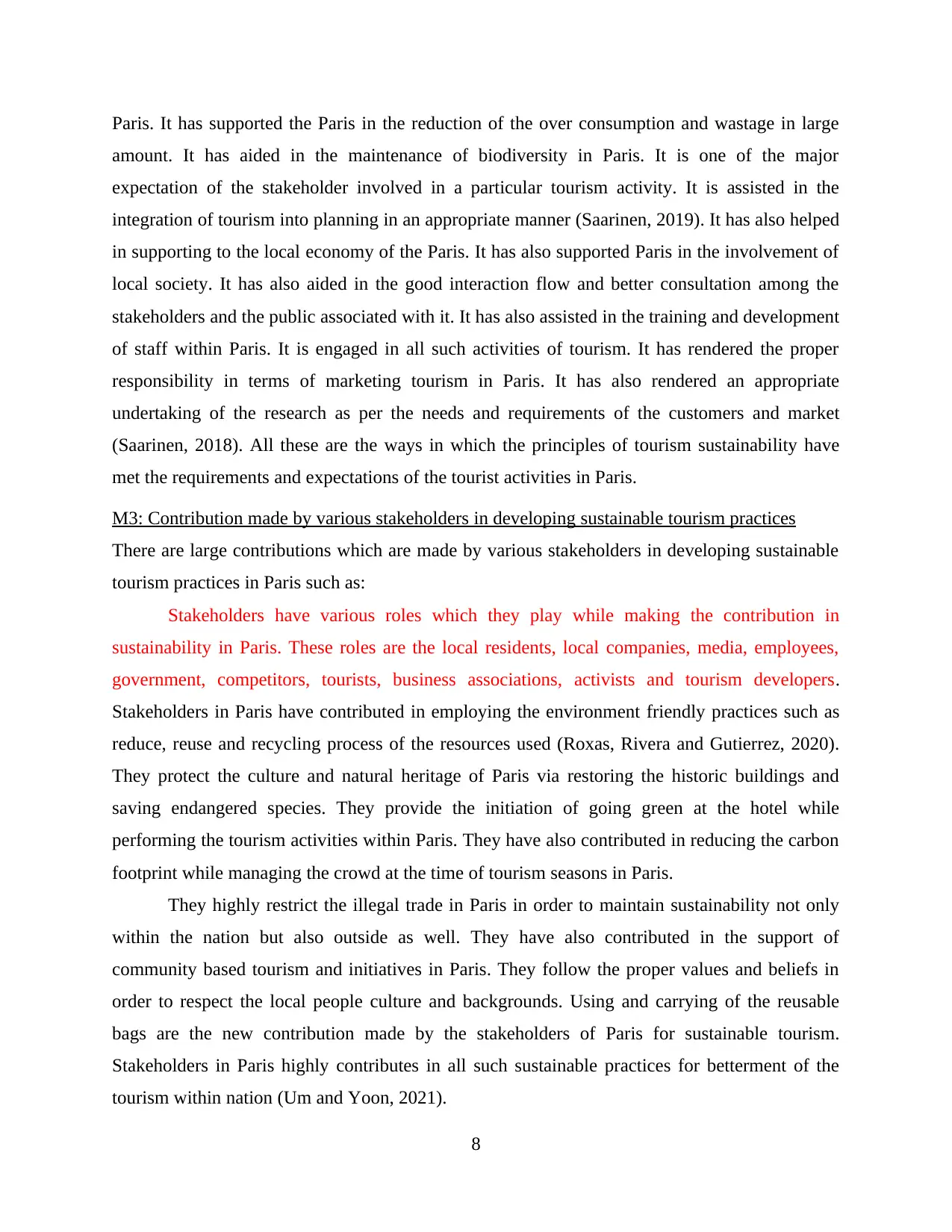
Paris. It has supported the Paris in the reduction of the over consumption and wastage in large
amount. It has aided in the maintenance of biodiversity in Paris. It is one of the major
expectation of the stakeholder involved in a particular tourism activity. It is assisted in the
integration of tourism into planning in an appropriate manner (Saarinen, 2019). It has also helped
in supporting to the local economy of the Paris. It has also supported Paris in the involvement of
local society. It has also aided in the good interaction flow and better consultation among the
stakeholders and the public associated with it. It has also assisted in the training and development
of staff within Paris. It is engaged in all such activities of tourism. It has rendered the proper
responsibility in terms of marketing tourism in Paris. It has also rendered an appropriate
undertaking of the research as per the needs and requirements of the customers and market
(Saarinen, 2018). All these are the ways in which the principles of tourism sustainability have
met the requirements and expectations of the tourist activities in Paris.
M3: Contribution made by various stakeholders in developing sustainable tourism practices
There are large contributions which are made by various stakeholders in developing sustainable
tourism practices in Paris such as:
Stakeholders have various roles which they play while making the contribution in
sustainability in Paris. These roles are the local residents, local companies, media, employees,
government, competitors, tourists, business associations, activists and tourism developers.
Stakeholders in Paris have contributed in employing the environment friendly practices such as
reduce, reuse and recycling process of the resources used (Roxas, Rivera and Gutierrez, 2020).
They protect the culture and natural heritage of Paris via restoring the historic buildings and
saving endangered species. They provide the initiation of going green at the hotel while
performing the tourism activities within Paris. They have also contributed in reducing the carbon
footprint while managing the crowd at the time of tourism seasons in Paris.
They highly restrict the illegal trade in Paris in order to maintain sustainability not only
within the nation but also outside as well. They have also contributed in the support of
community based tourism and initiatives in Paris. They follow the proper values and beliefs in
order to respect the local people culture and backgrounds. Using and carrying of the reusable
bags are the new contribution made by the stakeholders of Paris for sustainable tourism.
Stakeholders in Paris highly contributes in all such sustainable practices for betterment of the
tourism within nation (Um and Yoon, 2021).
8
amount. It has aided in the maintenance of biodiversity in Paris. It is one of the major
expectation of the stakeholder involved in a particular tourism activity. It is assisted in the
integration of tourism into planning in an appropriate manner (Saarinen, 2019). It has also helped
in supporting to the local economy of the Paris. It has also supported Paris in the involvement of
local society. It has also aided in the good interaction flow and better consultation among the
stakeholders and the public associated with it. It has also assisted in the training and development
of staff within Paris. It is engaged in all such activities of tourism. It has rendered the proper
responsibility in terms of marketing tourism in Paris. It has also rendered an appropriate
undertaking of the research as per the needs and requirements of the customers and market
(Saarinen, 2018). All these are the ways in which the principles of tourism sustainability have
met the requirements and expectations of the tourist activities in Paris.
M3: Contribution made by various stakeholders in developing sustainable tourism practices
There are large contributions which are made by various stakeholders in developing sustainable
tourism practices in Paris such as:
Stakeholders have various roles which they play while making the contribution in
sustainability in Paris. These roles are the local residents, local companies, media, employees,
government, competitors, tourists, business associations, activists and tourism developers.
Stakeholders in Paris have contributed in employing the environment friendly practices such as
reduce, reuse and recycling process of the resources used (Roxas, Rivera and Gutierrez, 2020).
They protect the culture and natural heritage of Paris via restoring the historic buildings and
saving endangered species. They provide the initiation of going green at the hotel while
performing the tourism activities within Paris. They have also contributed in reducing the carbon
footprint while managing the crowd at the time of tourism seasons in Paris.
They highly restrict the illegal trade in Paris in order to maintain sustainability not only
within the nation but also outside as well. They have also contributed in the support of
community based tourism and initiatives in Paris. They follow the proper values and beliefs in
order to respect the local people culture and backgrounds. Using and carrying of the reusable
bags are the new contribution made by the stakeholders of Paris for sustainable tourism.
Stakeholders in Paris highly contributes in all such sustainable practices for betterment of the
tourism within nation (Um and Yoon, 2021).
8
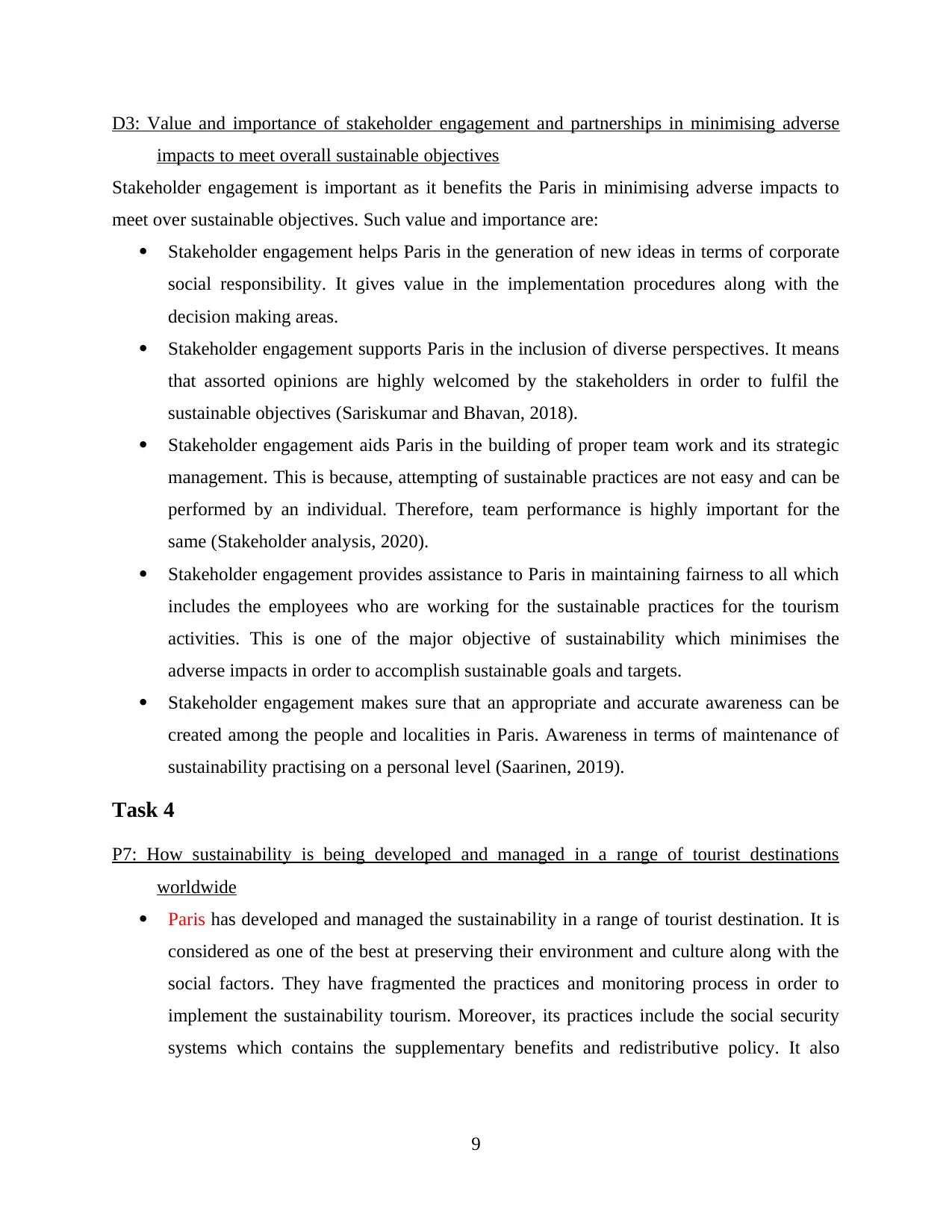
D3: Value and importance of stakeholder engagement and partnerships in minimising adverse
impacts to meet overall sustainable objectives
Stakeholder engagement is important as it benefits the Paris in minimising adverse impacts to
meet over sustainable objectives. Such value and importance are:
Stakeholder engagement helps Paris in the generation of new ideas in terms of corporate
social responsibility. It gives value in the implementation procedures along with the
decision making areas.
Stakeholder engagement supports Paris in the inclusion of diverse perspectives. It means
that assorted opinions are highly welcomed by the stakeholders in order to fulfil the
sustainable objectives (Sariskumar and Bhavan, 2018).
Stakeholder engagement aids Paris in the building of proper team work and its strategic
management. This is because, attempting of sustainable practices are not easy and can be
performed by an individual. Therefore, team performance is highly important for the
same (Stakeholder analysis, 2020).
Stakeholder engagement provides assistance to Paris in maintaining fairness to all which
includes the employees who are working for the sustainable practices for the tourism
activities. This is one of the major objective of sustainability which minimises the
adverse impacts in order to accomplish sustainable goals and targets.
Stakeholder engagement makes sure that an appropriate and accurate awareness can be
created among the people and localities in Paris. Awareness in terms of maintenance of
sustainability practising on a personal level (Saarinen, 2019).
Task 4
P7: How sustainability is being developed and managed in a range of tourist destinations
worldwide
Paris has developed and managed the sustainability in a range of tourist destination. It is
considered as one of the best at preserving their environment and culture along with the
social factors. They have fragmented the practices and monitoring process in order to
implement the sustainability tourism. Moreover, its practices include the social security
systems which contains the supplementary benefits and redistributive policy. It also
9
impacts to meet overall sustainable objectives
Stakeholder engagement is important as it benefits the Paris in minimising adverse impacts to
meet over sustainable objectives. Such value and importance are:
Stakeholder engagement helps Paris in the generation of new ideas in terms of corporate
social responsibility. It gives value in the implementation procedures along with the
decision making areas.
Stakeholder engagement supports Paris in the inclusion of diverse perspectives. It means
that assorted opinions are highly welcomed by the stakeholders in order to fulfil the
sustainable objectives (Sariskumar and Bhavan, 2018).
Stakeholder engagement aids Paris in the building of proper team work and its strategic
management. This is because, attempting of sustainable practices are not easy and can be
performed by an individual. Therefore, team performance is highly important for the
same (Stakeholder analysis, 2020).
Stakeholder engagement provides assistance to Paris in maintaining fairness to all which
includes the employees who are working for the sustainable practices for the tourism
activities. This is one of the major objective of sustainability which minimises the
adverse impacts in order to accomplish sustainable goals and targets.
Stakeholder engagement makes sure that an appropriate and accurate awareness can be
created among the people and localities in Paris. Awareness in terms of maintenance of
sustainability practising on a personal level (Saarinen, 2019).
Task 4
P7: How sustainability is being developed and managed in a range of tourist destinations
worldwide
Paris has developed and managed the sustainability in a range of tourist destination. It is
considered as one of the best at preserving their environment and culture along with the
social factors. They have fragmented the practices and monitoring process in order to
implement the sustainability tourism. Moreover, its practices include the social security
systems which contains the supplementary benefits and redistributive policy. It also
9
⊘ This is a preview!⊘
Do you want full access?
Subscribe today to unlock all pages.

Trusted by 1+ million students worldwide
1 out of 16
Related Documents
Your All-in-One AI-Powered Toolkit for Academic Success.
+13062052269
info@desklib.com
Available 24*7 on WhatsApp / Email
![[object Object]](/_next/static/media/star-bottom.7253800d.svg)
Unlock your academic potential
Copyright © 2020–2025 A2Z Services. All Rights Reserved. Developed and managed by ZUCOL.





![Sustainable and Responsible Tourism Management Report - [Course Name]](/_next/image/?url=https%3A%2F%2Fdesklib.com%2Fmedia%2Fimages%2Ftt%2F97543c1e789843e897460d59424ee454.jpg&w=256&q=75)